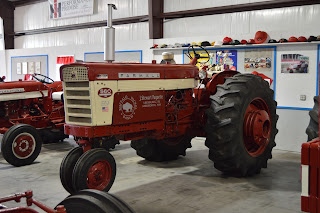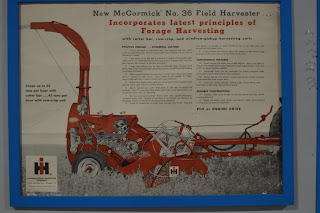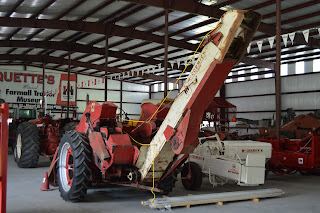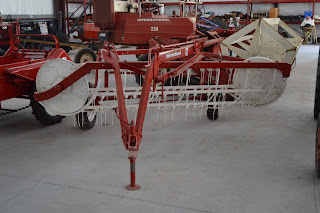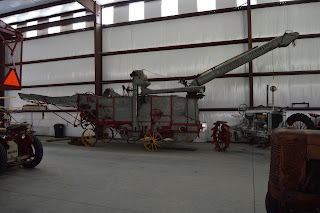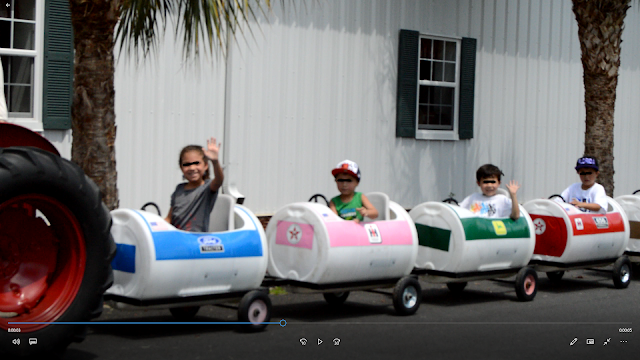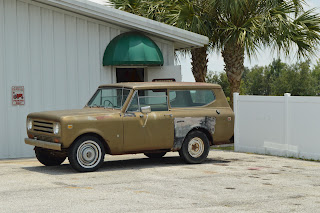This is one of those topics for which I took so many photos in the museum that I was intimated by the prospect of discussing the museum. This post has motivated me to find the photos and use them since I spent some time looking for some notes that did not exist.
Since I have more upload bandwidth (I clocked 40mbs for this upload) than time, I'm basically doing a photo dump. Having looked at them, I'm disappointed that I didn't get photos of their kitchen display. IH used to make refrigerators
. Then IH sold the plant to Whirlpool and got out of the appliance business. That plant also made Kelvinator refrigerators for Sears. I heard that Whirlpool closed that plant because of local labor issues.
Fortunately, this video shows the home appliances display at
1:12. I see they made washing machines as well.
The museum also had restored a Ford. If I remember correctly, they restored this for someone else as contract work.
This is at the front of the main building.
I skipped getting detailed shots of the "shiny" tractors because there are so many of them. But I took these two 560s because Stew used them in pulling contests and won some trophies. The above video focused on the shiny tractors, so we nicely complement each other.
On the walls were various posters that IH produced, but these need camera resolution to read, and I can't do that with the blog. But you can see the type of information that they provided to the farmers.
I visited this place in Aug 2014, which was the first Summer after I started writing the blogs. So this was my first exposure to an orchard tractor. That is why I took so many photos of it. The extra sheathing helped keep the low hanging fruit trees out of the tractor.
It is hard to capture how many tractors were in this building.
I was excited to see an M because my Grandfather's brother had an H and a M. Later, after several months of going to tractor shows to get photos for the blog, I realized that H and M tractors are rather common.
Lighting was a challenge sometimes. I didn't notice that I let the camera shake while I took this photo. It looks like a nice summary of the history of IH tractors. Taking a better photo of this poster might motivate me to revisit the museum.
"My dad just spent $4,027 on a set of new Straw Walkers for our combine."
"Gee, my dad hasn't bought a Straw Walker since 1977 when he switched to the Axial-Flow."
An article about Stew's Stuff.
I must have heard the shutter click when I took the above. So I tried again being careful to hold the camera steady. Unfortunately, it still moved. Since 2014, I've learned to change the ISO setting, bought a Vibration Reduction lens and bought a monopod.
Red is the transmission, yellow is the Torque Amplifier and blue is the independent PTO.
This was a "fan" type chopper as opposed to a "lawn mower" type. By Grampa had a MM fan-type chopper.
Then I went across a drive to another building. They have some bigger stuff parked outside.
1970 Scout 800A. Someplace in my 1000s of posts I've talked about how my Dad used to work for US Rubber in Fort Wayne. But then it got layed off because US Rubber closed the plant. Since it was near IH's truck manufacturing plant, IH bought it and converted it to make Scouts.
I walked past the shiny tractors in the front of the building such as the gold demo tractors and focused on the stuff with "character."
I digitally zoomed in to the rollers that pop the ears off for my
corn picker post.
I'm zooming in trying to figure out how the machine removes the husks.
I took a lot of photos of the little-square bailers because I had already learned that it was hard to find photos of them, let alone the real deal.
The crank that runs the plunger.
The knotter is off to the right.
The knotter. I still haven't figured out how they work.
They do repairs in the far back of the building.
A crimper is another rare implement to find.
I wonder what the blue plow with the red PTO-driven augur does. I didn't notice it while I was in the museum. Discovering it while taking a look at the photos is one of the advantages of taking photos. (The video called this a terracer.)
I've seen this called a haybine. It is a self-propelled mower with the crimper built in. (The video called it a windrower.)
A hay rake.
An old ground-driven manure spreader. Manure spreaders are older than tractors. In the 1800s they had wheels under the front and were pulled by horses. When IH was formed, most of the farm manufactures were making harvesters. One reason why IH was formed was to reduce the redundancy of harvest manufacturing by using some of the plants to build other things. I forget which plant was chosen to build the manure spreaders.
This is the rear of the cotton picker photographed below.
I was trying to get a shot of the spindles that stab the cotton balls.
Now we are getting back to the horse & buggy days.
This binder is folded up for travel (and storage).
Some of the shiny tractors.
This is a closeup of the "before" photo at the front of the tractor below.
It struck me that there was no PTO and just one hydraulic circuit.
Another "before" photo.
A detail on the side.
I try to take a photo of the back as well as the front because that is where a lot of the technology development of tractors shows.
IH made trucks.
A lot of farmers were mad that Case killed Farmall, especially the
2+2, when Tenneco bought the IH farm operation. In fact, Tenneco didn't even buy
the huge Farmall plant in Rock Island.
I zoomed in for the model number and date.
I found the stuff out behind the buildings more interesting than the shiny tractors. It looks like they make this 460 earn its keep by mowing the lawn.
A seed drill with one of the flexible pipes missing.
A
feedmill with some shields missing so that you can see the big pulley on the PTO shaft and the small one on the hammer-mill shaft so that the hammer mill will spin a lot faster. Lots of belts were used because most of the horsepower of the tractor was going to the hammer mill to grind the feed. That is, the tractor is stationary when they are grinding and mixing the feed.
When they fold the augur straight for unloading, those gears mesh to drive the extension augur.
Another drill. I took a lot of photos because I knew these were hard to find.
A baler with its own engine. It looks like it used a wide flat belt instead of a bunch of V-belts between the engine and the baler.
They used to host tractor pull shows.
The economics of digital photography allows one to take photos early and often.
When I first arrived, there was a "train" of cars being pulled by a tractor. These two screenshots are from a 3 second video I took as the train passed me. I'm not posting the video because 3 seconds is too short, I don't know how to degrade faces in a video, it was out of focus and I tilted the camera.
This screenshot shows the cars being pulled by the tractor.
I thought it was interesting that all of the kids quickly picked up that there was a camera following them and they all started waving.
They use a Scout for their everyday transportation needs.





















.jpg)








